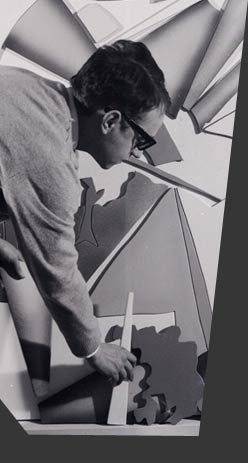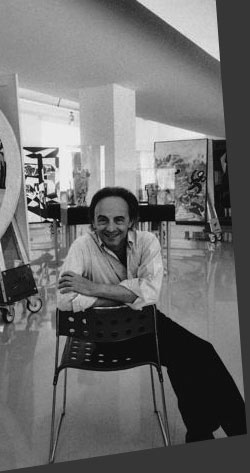Maurizio Ferraris
NESPOLO: BETWEEN WARHOL AND RILKE
It is hard to imagine a better location for Nespolo's works than the Bargello, in Florence. The Bargello is the epitome of a reusable space: it has been used for various political and legal purposes, but also as a prison. Indeed, it used to be full of instruments of torture, which in the mid-eighteenth century Leopold of Lorraine melted to celebrate (deluding himself a little) the end of the dark ages. But is it so strange that such a palace should become a museum? In the city of the Uffizi Galleries, this should not be that surprising. Offices (Uffizi) gather documents, inscribed acts, things that involve at least two people and that have value precisely because they survive - they leave a trace.
This is why there are entire palaces - be they ministries or banks, archives or registry offices, libraries or police stations - collecting documents, those documents whose burning often accompanies the end of a regime. The need for registration and recording (the need for paperwork) is the main characteristic of the social world, namely the world of promises and bets, money and works of art, which includes the most important things in our lives - those affecting our happiness or unhappiness. In the hierarchy of values (and often prices) of social objects, a special place is occupied by inscriptions that are supposed to move or amuse us, frighten us or make us think, or even just make us look good in society: that is, works of art. Now, what are artworks if not documents - inscribed acts involving an author and a recipient, an artist and a client? Acts that have no value unless they find expression and inscription? Do not believe someone who tells you he has got a whole novel in his head, and only has to write it. That novel simply does not exist, for the same reason why a bet, a promise, a banknote or a marriage do not exist until they are recorded. Indeed, a work of art begins to exist only in the presence of expression and inscription; this tells us (and Nespolo knows this better than anyone else) how important the actual work (understood as labour) is in art: craft is the mother of all arts, and, in the end, it is true that genius is first of all diligence. Therefore, in the office called Bargello, hundreds of documents were gathered over time. They comprise treaties and sentences, concerning many people including Machiavelli (who was locked up and tortured here in 1513) and Donatello: a sculptor, goldsmith, designer-that is, once again, an inscriber. So, it seems only normal-indeed, only right-that the Bargello should also host Nespolo's artistic documents, which are some among the most document-like works of contemporary art. Nespolo's art is openly, consciously, admittedly and brilliantly about documentality.
Did you see how much writing there is about his works, in his works? And how often he likes to work with those other tireless manufacturers of inscriptions we call writers and screenwriters? Nespolo's artistic vocation must have begun when he was told to show his "licence and registration, please". Luckily, instead of those documents he gave us his art, his thousand artworks occupying the most varied locations, revealing the depth of his great Pop Art (this, at least, is my interpretation). Pop here does not mean "popular"- or, even worse, "populist" - but, on the contrary, bearer of a critical view for which there is nothing so low as not to deserve attention, but there's also nothing so high as not to deserve a sneer. Someone endorsing such a view could only end up at the great archive of the Bargello-luckily, things have changed (at least a little bit) since the days of Machiavelli.
This is the first thread connecting the Office of the Bargello and Nespolo's own office, where he tirelessly produces documentality. But there is also another thread, which is just as important. This time, instead of starting from the Bargello, let us start from Nespolo-or better, his office / workshop / factory in Turin. I would spend entire days there: that place is the kingdom of fetishism, which is the reasonable and polite answer to narcissism. It hosts a huge collection of objects: everywhere are objects, chairs, cameras, musical instruments, books, jukeboxes, puppets, robots, and Nespolo wanders around them like Superman in the Fortress of Solitude.
The only difference is that, luckily, this place is not at the North Pole, and there are even hanging gardens and Neapolitan majolicas. Well, the Bargello is not too different. Once become a museum it, too, has gathered the most diverse things-bronzes, porcelain, textiles, statues and rings - in a huge fetishist accumulation. These are "minor arts", as they
say, mostly referring to their size-forgetting that, if so, a large nineteenth century canopy in cast iron (say, the structure of the Crystal Palace) should be considered "major art", and the Great Wall or the skyscrapers in Dubai should be called "huge". The truth is that minor arts, which are defined such with formidable inaccuracy and unfairness, say a lot about art: that is, they show that artworks are first of all objects, sundry items of modest size-the furniture of our lives.
There is no fundamental discontinuity between an ornament and an artwork, or between advertisement and art: this is Nespolo's great lesson, as we can see at the Bargello as well as in his workshop in Turin. So, the Nespolo Factory, this junk dealer's warehouse, is a full-fledged museum, just like the Bargello. And, note well, just as in the case of documents, this is not an exception, but the rule. If we go to Dresden, or to the Castello Sforzesco, or anywhere else, to any other museum, we will find the same things: objects that, at some point, have become artworks-and were not expecting that. A scimitar never knew that one day it would be showcased in a gallery for the benefit of tourists. Someone who commissioned a coffin never knew that one day that coffin would be exposed in a museum next to coins and buckles... Let alone with himself, if he considered being embalmed-like the Pharaohs, who have become strange objects of body art that now delight (or, more often, horrify) school children visiting Egyptian museums. Nespolo's warehouse and the Egyptian Museum in Turin are not that far apart-about three kilometres according to Google Maps.
The Bargello is a bit more distant in space, but not as a concept. So, what is this concept? I would say it is ultimately the reason behind readymades: it is not that anything can be a work of art, but rather that art is above all a thing. I believe that, with the pissoir, Duchamp wanted to send a nihilistic message: "anything can be a work of art, this urinal, this bicycle wheel. I figured this out, because I'm so clever, while you lot still think that an artwork is made such by some intrinsic value." However-as Nespolo shows with his works, so different from Duchamp's, as they are indeed beautiful-there is a sense in which the ready-made is actually the opposite of nihilism. It is love for the object, the sanctification of the object. After all, so to speak, the ready-made has two theoretical senses and two directions. The first goes top to bottom (the moustache on the Mona Lisa, the urinal in the gallery).
The second, expressed by Nespolo, goes instead from the bottom up, finding beauty and nobility in the objects around us, and consecrating them. After all, this is what we do when we decide to put an object on our shelves-not to use it, but because we like it-or when we keep some instrument that is no longer needed. In this sanctification of the object, in this ready-made art going from the bottom up, Nespolo does not relate to the nihilist Duchamp, but rather to the fetishist Warhol. Warhol liked beautiful things and found beauty in the wonders of commercial goods-/e bonheur des femmes, just like Zola's novel. He did not even contemplate exposing and magnifying something radically ugly and insignificant. Along this line, Nespolo goes a bit further and does not merely sanctify Campbell's soups or Brillo boxes but tries to produce objects himself-there is a whole other side to his work that should be analysed, namely his activity as an advertisement artist, which I cannot address here. I have gone on for too long and have to conclude. What I wanted to say, in the end, is this: Nespolo's Pop Art-despite its ironic vein, or perhaps because of it-surprisingly echoes Rilke's Duino Elegies:
Praise the world to the angel, not the unsayable one, you can't impress him with glorious emotion; in the universe where he feels more powerfully, you are a novice. So, show him something simple which, formed over generations, lives as our own, near our hand and within our gaze. Tell him of Things- He will stand astonished; as you stood by the rope-maker in Rome or the potter along the Nile. Show him how happy a Things can be, how innocent and ours, how even lamenting grief purely decides to take form, serves as a Thing, know you are praising them; transient, they look to us for deliverance: us, the most transient of all.
(From the book: Ugo Nespolo Novantiqua, Museo Nazionale del Bargello, Firenze, 2009, Giunti Editore, Firenze)



